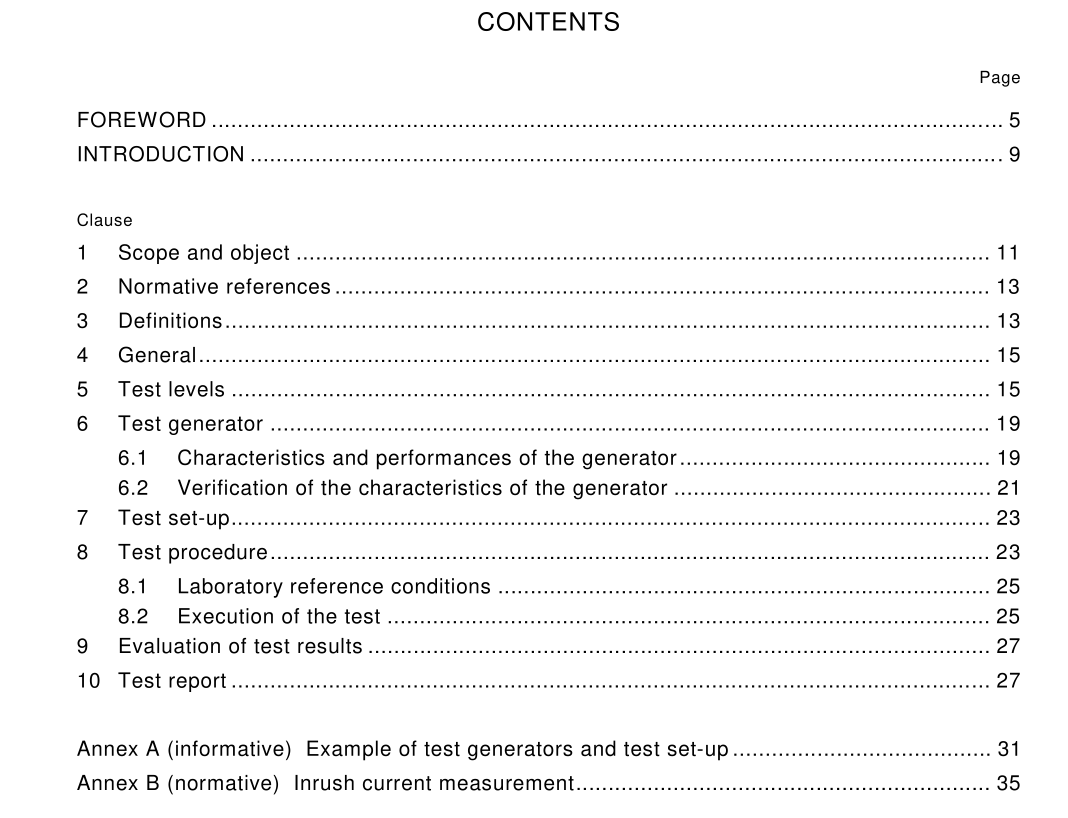IEC 61000-4-29 pdf download

IEC 61000-4-29 pdf download.Electromagnetic compatibility (EMC)
1 Scope and object
This part of IEC 61 000 defines test methods for immunity to voltage dips, short interruptions and voltage variations at the d.c. input power port of electrical or electronic equipment. This standard is applicable to low voltage d.c. power ports of equipment supplied by external d.c. networks. The object of this standard is to establish a common and reproducible basis for testing electrical and electronic equipment when subjected to voltage dips, short interruptions or voltage variations on d.c. input power ports. This standard defines: – the range of test levels; – the test generator; – the test set-up; – the test procedure. The test described hereinafter applies to electrical and electronic equipment and systems. It also applies to modules or subsystems whenever the EUT (equipment under test) rated power is greater than the test generator capacity specified in clause 6. The ripple at the d.c. input power port is not included in the scope of this part of IEC 61 000. It is covered by IEC 61 000-4-1 7 1 ) This standard does not specify the tests to be applied to particular apparatus or systems. Its main aim is to give a general basic reference to IEC product committees. These product committees (or users and manufacturers of equipment) remain responsible for the appropriate choice of the tests and the severity level to be applied to their equipment.
4 General
The operation of electrical or electronic equipment may be affected by voltage dips, short interruptions or voltage variations of the power supply. Voltage dips and short interruptions are mainly caused by faults in the d.c. distribution system, or by sudden large changes of load. Is also possible for two or more consecutive dips or interruptions to occur. Faults in the d.c. distribution system may inject transient overvoltages into the distribution network; this particular phenomenon is not covered by this standard. Voltage interruptions are primarily caused by the switching of mechanical relays when changing from one source to another (e.g. from generator set to battery). During a short interruption, the d.c. supply network may present either a “high impedance” or “low impedance” condition. The first condition can be due to switching from one source to another; the second condition can be due to the clearing of an overload or fault condition on the supply bus. The latter can cause reverse current (negative peak inrush current) from the load. These phenomena are random in nature and can be characterised in terms of the deviation from the rated voltage, and duration. Voltage dips and short interruptions are not always abrupt. The primary cause of voltage variations is the discharging and recharging of battery systems; however they are also created when there are significant changes to the load condition of the d.c. network.
6 Test generator
The following features are common to the generator for voltage dips, short interruptions and voltage variations, except where otherwise indicated. The generator shall have provisions to prevent the emission of disturbances which may influence the test results. Examples of generators are given in figure A.1 (test generator based on two power sources with internal switching) and figure A.2 (test generator based on a programmable power supply).NOTE The slew rate of the voltage change at the output of the generator can range from a few V/µs up to hundreds V/µs, depending on the output voltage change. A test generator with U o = 360 V dc and I o = 25 A is recommended to cover the great number of test requirements. In case of systems with rated power exceeding the generator capability, the tests shall be performed on individual modules/subsystems. The use of a generator with higher or lower voltage/current capability is allowed provided that the other specifications (output voltage variation with the load, rise and fall time of the voltage change, etc.) are preserved. The test generator steady state power/current capability shall be at least 20 % greater than the EUT power/current ratings.









